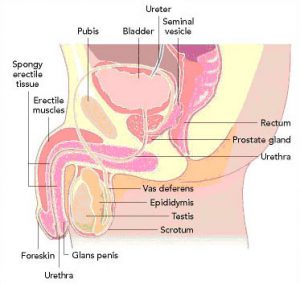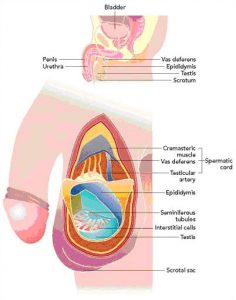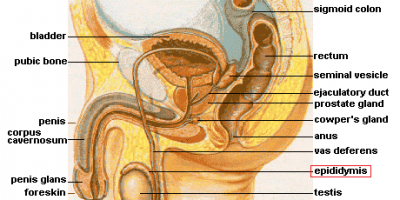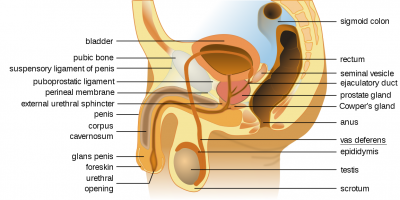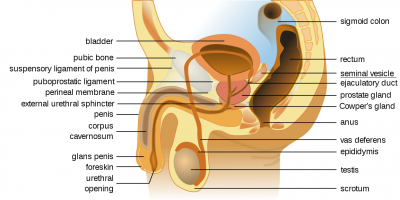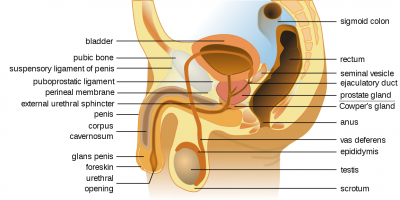The Basics of the Origin of Life - Male
The testes are the essential sex organs (gonads) in the male that serve to produce the male gametes (sperms) and the male sex hormone testosterone. The accessory male reproductive glands aid in the maturation, nourishment and transport of the sperms through the male reproductive system and into the female’s body for fertilization. Unlike the female reproductive structures that are located within the pelvic cavity, the male reproductive organs lie outside the abdomen. The male reproductive structures and their locations are shown in the figure.
The testicles lie outside of the abdomen, suspended in a fleshy sack called the scrotum. Testes are made from the same embryonic material that becomes the ovaries in the female. The testes develop within the abdomen, but about two months before birth they descend through the abdominal wall into the scrotum. The testes are connected to the body through scrotal tissue and two spermatic cords that are composed of nerves, blood vessels and the vas deferens, or sperm ducts.
The functions of the testes are to produce sperm and the male sex hormone testosterone. In order to produce and nurture sperm, the temperature within the testes must remain approximately 1-2�C cooler than normal body temperature. Part of the function of the scrotum is to maintain this optimal temperature by holding the testes further from the body during warm weather or contracting and bringing them closer to the body during cold weather.
The testes are composed of narrow, tightly coiled structures called seminiferous tubules. The testes also contain interstitial Leydig’s cells and Sertoli’s cells. The Leydig cells produce testosterone.
The Sertoli cells nurture the immature sperm by mechanically supporting and protecting them until they can reach maturity and are released into the tubules. Sertoli cells also play an active role in releasing the mature sperm into the tubules. The various structures within the testes are shown in the following cross-sectional diagram.
The vas deferens is a long curving tube that begins at the tail end of the epididymis and rises out of the scrotum into the abdominal region. It then passes over the urinary bladder and connects to the seminal vesicle in the pelvic region to form the ejaculatory duct. Besides functioning as part of the sperm transport system, it also acts as a storage site for most of the sperm produced until ejaculation. The entire process of sperm maturation, from their primitive beginnings in the seminiferous tubules to their fully mature form in the vas deferens, takes about 74 days.
The seminal vesicles are two pouches located in the pelvic region behind the urinary bladder. Their primary purpose is to supply a viscous, alkaline secretion that forms a part of the seminal fluid. Seminal fluid is often referred to as semen and includes secretions from the seminal vesicles, prostate and bulbourethral glands, as well as sperm cells. The seminal vesicles supply about 30% of the seminal fluid volume. The fluid from the seminal vesicles is rich in nutrients, including citric and amino acids and fructose to provide an energy source for sperm metabolism and to enhance sperm motility.
The prostate gland, the largest of all the male reproductive glands, is chestnut-sized and located just below the bladder, near the exit of the urethra. The prostate contributes about 60% of the seminal fluid, secreting a thin, milky-white alkaline fluid similar to that of the seminal vesicles. The fluid is discharged into the urethra during ejaculation to help neutralise the acidic fluids in the male urethra and the female vagina. This function is important because acids can have an adverse effect on sperm and, at higher concentrations, can kill them.
The urethra is a tube running from the bladder through the prostate gland to the end of the penis, forming the final section of the seminal fluid passageway. The urethra functions as the exit point for both semen and urine. The closing of muscular sphincters automatically blocks the flow of one process when the other is occurring.
The bulbourethral glands (sometimes called Cowper’s glands) are two pea-sized glands located just below the prostate. They also secrete an alkaline fluid, although it amounts to less than 5% of the seminal fluid volume.
The penis is the male organ through which both sperm and urine pass from the body. It is covered by a loose layer of skin and is composed of sponge-like erectile tissue containing large sinuses interspersed with veins and arteries. During sexual stimulation, the arteries dilate and the penis becomes erect as the spongy tissues fill with blood. The tissue at the end of the penis forms the glans penis. In an uncircumcised male, a fold of loose skin called the foreskin covers the glans penis. In the process of ejaculation, the penis delivers sperm contained in seminal fluid into the female’s body for fertilization of the ovum.
Organs of the male reproductive system |
|||||||||||
| Structure | Description | Function | |||||||||
|---|---|---|---|---|---|---|---|---|---|---|---|
| Scrotum | Loose sack of skin containing the testes. | Holds testes Maintains proper temperature in the testes. | |||||||||
| Spermatic Cords | Two cords attached to the testes. | Help attach testes to scrotum Function as sperm ducts. | |||||||||
| Epididymis | Long curved tube running off the epididymis into abdominal region. | Sperm storage and transport. | |||||||||
| Seminal vesicles | Two pouches located in pelvic region behind bladder. | Produce elements of seminal fluid, which transports and nourishes sperm. | |||||||||
| Prostate gland | Chestnut-sized gland located below the urethra. | Produces elements of seminal fluid, which transports and nourishes sperm. | |||||||||
| Ejaculatory ducts | Two short tubes descending through the prostate gland into the urethra. | Form merger point between the vas deferens and the seminal vesicle. | |||||||||
| Urethra | Tube running from the bladder through the prostate to the end of the penis. | Final portion of sperm transport system. Also carries urine from body. | |||||||||
| Bulbourethral glands | Also called Cowper's glands Two pea-sized glands located below the prostate gland. | Secrete small amounts of seminal fluid. | |||||||||
| Penis | Male sex organ extending out from the abdomen and comprised of erectile tissue, blood vessels and sinus cavities | Delivers sperm into the female's body. Eliminates urine from the body. | |||||||||

